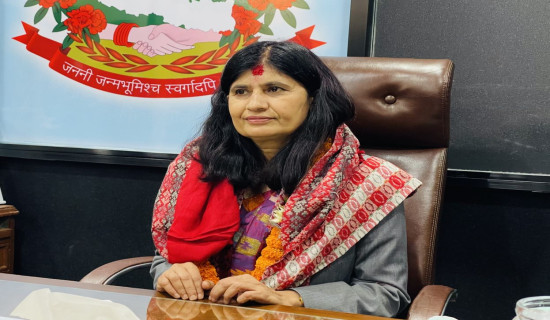- Sunday, 31 August 2025
Dust, dry fields in July: A sign of drought in Madhesh
By Binay Karna,Saptari, July 13: For farmers, it is not a good sign when dust rises from the roads during Asar and Shrawan (June/July). “It means drought is on the way,” said 78-year-old farmer Binhai Khanga from Rupani Rural Municipality-4. His words reflect the current state of the paddy plantation in Madhes.
“This is the season for muddy roads and fields covered in mud. Flying dust indicates trouble,” he said, and his concerns are reflected in the situation across the Madhes region.
Paddy is the main crop for farmers in the region. However, due to the lack of rain over the past month, only 16 per cent of paddy has been planted in Saptari, and just 25 per cent in the entire Madhes Province, according to the data.
Although some areas have managed to plant paddy using irrigation canals or boring systems, the water level underground is decreasing. As a result, borewells are also giving less water, making it hard to plant paddy or protect the seedlings already in the field.
In fields without proper irrigation, the paddy seedlings are drying out and cracks have started appearing in some planted fields. In recently ploughed fields, dust is beginning to rise again. Locals say that due to the continuous dry weather, some tube wells are also starting to dry up.
Of the total 81,000 hectares of cultivable land in Saptari, about 68,000 hectares are usually farmed. However, only about 23,800 hectares (roughly 32 to 34 per cent) currently have access to irrigation, according to the Agriculture Knowledge Centre in Saptari.
Droughts in Madhes over the years
Retired headmaster Narasimh Lal Karna, 75, from Rajbiraj-7, said that drought tends to occur every 20 to 25 years in the Madhes region. He recalled major droughts in 1950, 1972 and 1992.
He recalled that during the 1992 drought, his 10 kattha of land only produced four kilos of rice. However, he feels the current situation is slightly different from the past.
“Back then, farmers had no other option but to rely on rainfall. Today, we have alternatives like canals and boring systems. So, things are a bit easier now,” Karna said.
Similarly, farmer Binhai Khanga, 78, from Rupani-4, shared his memories of previous harsh droughts. He recalled a time when local farmers had to depend entirely on the rice they grew to meet all their household needs. He said that things have changed to a certain extent now.
"Although it is slightly better than before, it is still difficult to farm without rainfall. Not all fields get irrigation, and the falling water table means borewells are also failing in some areas. So even alternative irrigation is not always working,” he said.
Droughts and Mithila culture
Droughts have occurred in Madhes and the Mithila region from time to time. According to ancient belief, it was during such a drought in the Treta Yuga that King Janak began ploughing the fields, leading to the birth of Sita from the earth, and rain followed.
Cultural expert Dhirendra Premarshi said that during times of drought in Mithila culture, women would sing ritual songs and perform the traditional game called Jat-Jatin at night to please the rain god Indra.
“Jat-Jatin is not just a ritual. It shows the active role of women in farming. It is a way for them to share their joys and sorrows and express faith in the rain god,” he said.
Premarshi explained that women in Mithila are very active in farming. When there is no rain and planting stops, women feel restless. So, they engage in Jat-Jatin to stay connected to farming.
There is a belief in Mithila that it rains after women perform Jat-Jatin, just as people believe it rains in Kathmandu when the chariot procession of Red Machhindranath takes place.
He shared examples of both Jat-Jatin in Mithila and the Rato Machhindranath festival in Kathmandu being followed by rainfall.








-square-thumb.jpg)








